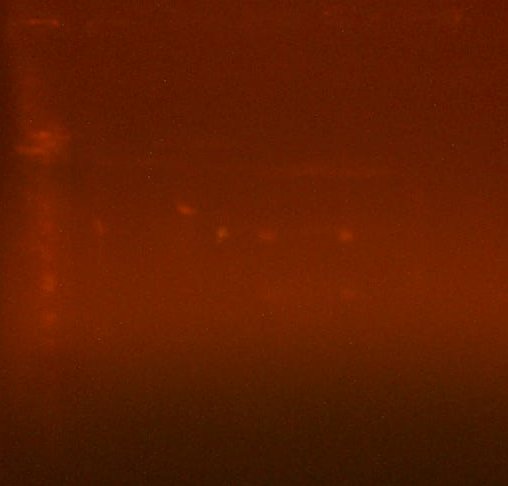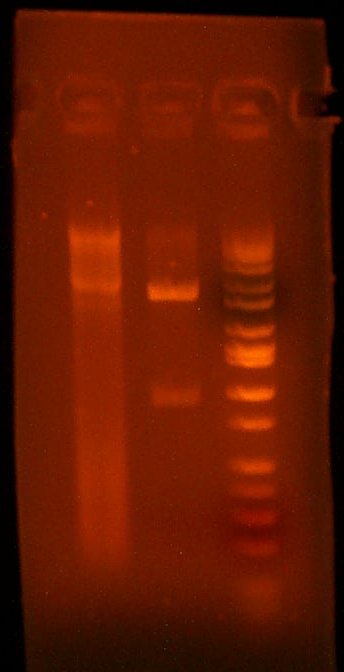David Tulga Notebook/ArchiveBasic1
From 2007.igem.org
<< Back to David Tulga's Notebook
Contents |
Low Copy ampR plasmid (pI716101) - Finished
Construction File: pI716101 (Low Copy ampR Plasmid - Produces RFP)
The midiprep of the plasmid pSB4A3-I7101 was successful, and I additionally digested and ligated the new 1144 Fragment into its EcoRI/XhoI insert to convert it into the Biobricks 2.0 Format.
The colonies grown from this ligation/transformation were both red and white - the red ones being the Bca9145-1144 parent vector, while the white colonies I picked appear to be the correct product.
I then did a test digest with PstI and HindIII, and the results indicated that the red colonies were parent, and the large white colonies were the correct product. Additionally, upon pelletization, the red colonies' cells appear distinctly red, while the white colonies appear slightly tinted red, which is the exact phenotype expected for the product, a low-copy plasmid with a RFP producing device.
June 19 to June 21: A midiprep of clone #3 (large white colony) was then done, and the plasmid DNA was run, as well as a mapping digest, with 4 different enzyme pairs, was performed. The plasmid DNA gel matched the expected size perfectly, and the mapping digest appears correct. I can eliminate the possibility of original biobricks 1.0 vector, as the product is cut with BglII, which was not present in the original vector. As well, the phenotype and size/map digest strongly support the indication that the product is correct. Therefore, clone #3 is confirmed to be correct, and likely clone 4 is likely additionally right, but has not been extensively tested.
June 25: I performed another Test Digest, this time with BglII and BamHI, which was expected to give two bands at 3159 and 901 for the expected product, and to leave the parent uncut. I ran it with parent and product on the same gel and it gave the exact expected result. Therefore, I saved clone #3 on the CloneSaver Card, as it is multiply confirmed.
pir (I716102) - Finished
Construction File: pir I716102 (R6K Origin Inducer)
I attempted many PCR reactions for pir, many of which failed, or gave too dilute a product to transform with. I additionally found that some of the incorrect colonies which were grown up from the first PCR product that appeared to succeed were actually primer dimers, and some were also mixed clones.
June 21: I have re-tried PCR from the overlap A+B step, as both the A and B products did succeed. The resulting transformation from that PCR has been grown up on an AMP plate.
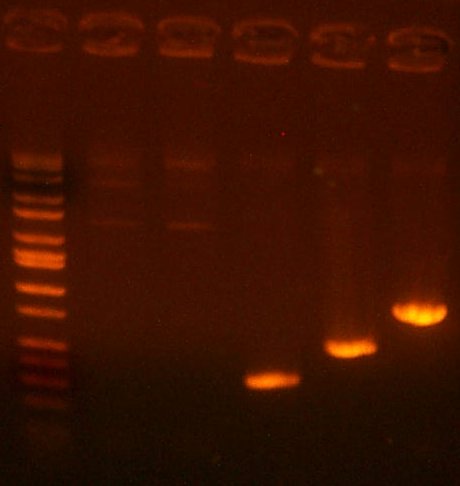
| The PCR gel, lane 1 is marker, 2 and 3 are failed T7 RNA Polymerases, ATG and GTG respectively, and lanes 3, 4, and 5 are the pir A, pir B, and combined overlap products, respectively. |
June 25: I have now cultured 4 white colonies from this transformation, and no obviously red colonies were spotted.
June 26: I have miniprep'd the 4 cultures I made yesterday. Additionally, a test digest was performed on the four minipreps, and all four came out exactly as expected - with two bands at 2652 and 344, when digested with HindIII, which cuts twice within the pir gene. Therefore, I sent all four samples off for sequencing today.
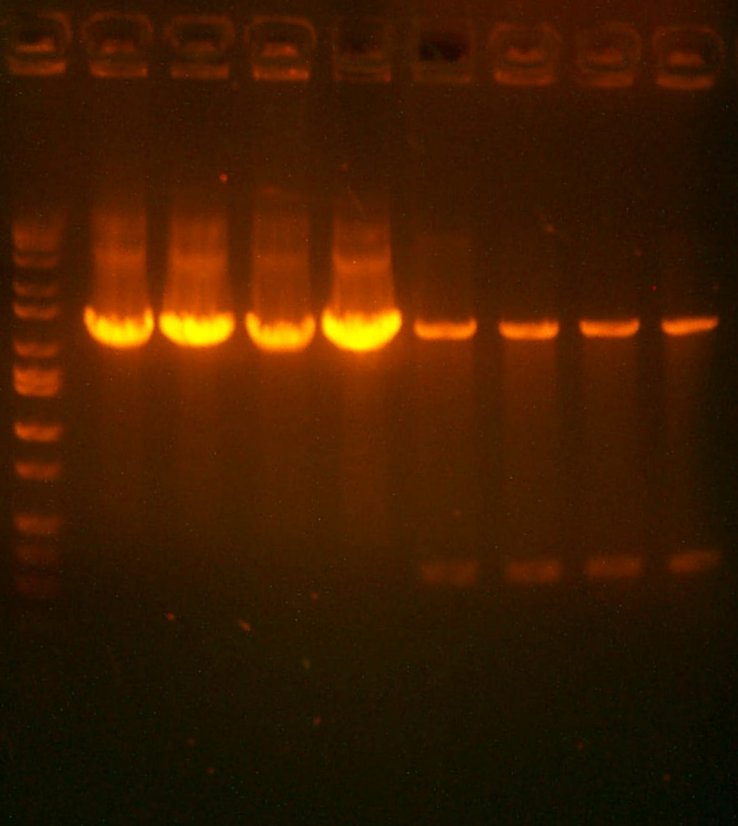
| The Test Digest gel. Lane 1 is marker, 2-5 are T7rnap PCRs, and the last 4 are the pir test digests. |
June 27: I received my sequencing results, and some mutations were found. However, clone #4 had no additional mutations beyond what was present in all 4 samples. Therefore, I believe that those mutations were present in the template sequence, as they are somewhat conservative non-silent mutations. Additionally, I sent off #4 for reverse sequencing, as the forward reads did not reach the end of the gene.
June 28: I now have the reverse read for clone #4 and it looked exactly correct, including the previously observed mutations, and so clone #4 is confirmed, and has been saved on the CloneSaver card.
T7 RNA Polymerase ATG and GTG starts (I716103, I716104) - Finished
Construction File: T7rnap I716103, I716104 (T7 RNA Polymerase)
I have attempted numerous PCR reactions for the T7 RNA Polymerases, and so far none have succeeded, either by returning no product, incorrect product due to mis-annealing, or genomic bleed through.
I will attempt the PCR reactions again, potentially from a different template, when we receive more Expand polymerase.
June 26: We now have more Expand polymerase, so I re-did the T7rnap PCRs with a new template Chris miniprep'd, and all 4 (2 ATG, 2 GTG) worked correctly. I then cleaned up the PCR products, and will then proceed to digest, ligate, and transform tomorrow.

| The PCR gel. Lane 1 is marker, lanes 2 and 3 are ATG Start PCRs, 4 and 5 are GTG Start PCRs, and the last 4 are the pir test digests. |
June 27: I have digested, ligated, and transformed the four PCR products into DH10B cells today, using Austin's backbone digest, and will grow the colonies up tomorrow.
June 29: Due to the incubator being turned off, I could not grow any colonies yesterday, as they were not visible, therefore, I grew up 8 colonies today in culture, to then miniprep on Monday. (After being placed in the refrigerator on Saturday)
July 2: I have miniprep'd the 8 colonies, then performed a test Digest with AlwNI. (AlwNI cuts within the backbone, and the T7rnap gene). All clones except 103 #3 looked correct, so I sent of clones 103 #2, #4 and 104 #2, #3.
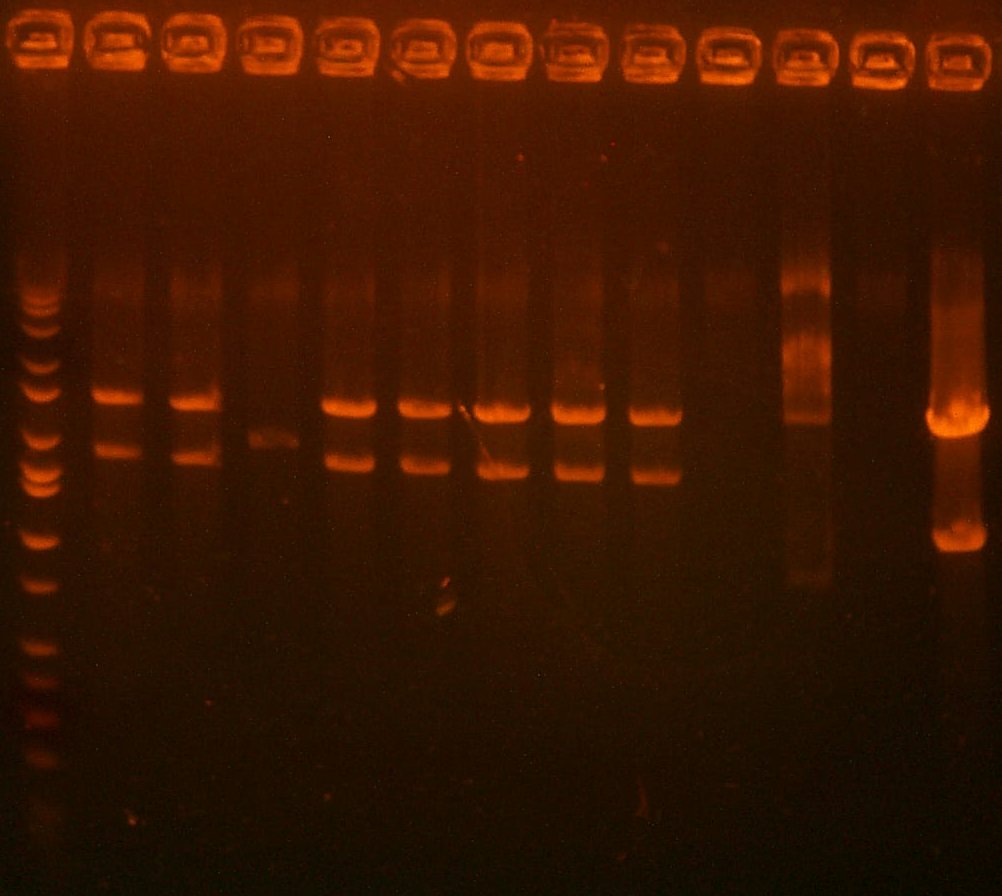
| The Test Digest Gel. Lane 1 is marker, lanes 2-5 are the ATG Start Digests, in clone order, 6-9 are the GTG Start Digests, also in clone order, and the last 2 are gel purification digests. |
July 3: I received the sequencing results from Quintara, and in all clones were some template mutations, but otherwise they were all perfect. However, as the T7rnap gene is rather long (2652bp), the reads did not reach the end, and I sent off all 4 samples for reverse sequencing.
July 4: I received the reverse sequencing results from Quintara. Again, the clones looked reasonable, with some template mutations.
July 9: I have now designed and ordered the oligos for sequencing the middle of the gene, as it is over 2500 bp long, it requires two oligos in the middle of the gene to read it fully.
July 10: Unfortunately, the sequencing indicated there is an Amber Stop Codon about 318 bp into the gene, meaning I will have to PCR again, from another template. This will be done from BL21 genomic DNA, so I took out the BL21 stock of the -80, and grew a stab directly in 5mL LB-only culture, for a genomic DNA prep tomorrow.
July 11: I have done a miniprep of the genomic DNA of the BL21 culture I grew, and the re-did the ATG and GTG PCRs for the T7rnap. The PCRs were successful, with a band at the exact expected sizes. I then digested, ligated, and transformed the parts and plated on AMP.
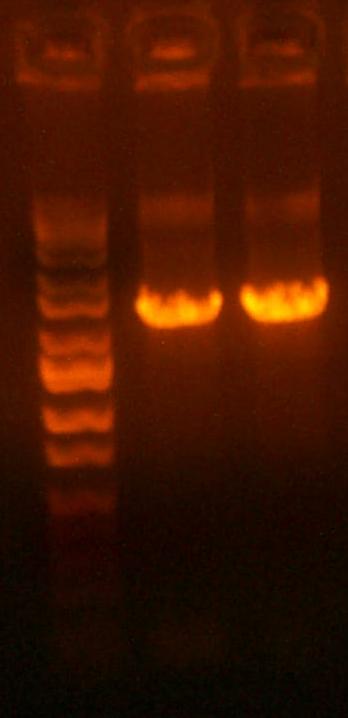
| The PCR gel. Lane 1 is marker, lanes 2 is the ATG Start PCR, and 3 is the GTG Start PCR. |
July 12: Both plates looked very good, and so I have picked 4 colonies from each plate and grew each in 5mL of LB+AMP Broth.
July 13: I miniprep'd the 8 T7 cultures, and test-digested with with AlwNI. All Except 103,1 and 103,2 are good - sent off sequencing for 103,3 ; 103,4 ; 104,1 ; and 104,2.
July 16: The sequencing results came back very good with no template mutations, and only one PCR mutation in one clone, I then sent off those four clones for reverse sequencing.
July 17: The clones 103,3 and 104,1 look the best, and so I have sent them off for middle 1 sequencing with oligo dt011-T7-seq1.
July 24: Those clones look correct, and I have sent them off for middle 2 sequencing with oligo dt012-T7-seq2. Additionally, activity is partially confirmed for the ATG and definitely for the GTG variants.
July 25: The sequencing came back good, with the GTG Start perfect, and the ATG Start having 1 mutation. As the ATG start is no longer being used in the further composite construction due to its excessive toxicity, and it appears to work, these are the final clones for now.
July 27: I have now saved clones 103,3 and 104,1 on the clone saver sheet.
T7 Promoter Variants (I716105, I716106, I716107) - Finished
Construction File: T7 Promoters I716105, I716106, I716107
I designed and ordered oligos to create the T7 promoters synthetically, as their short length (29bp), and multiple variants (Wild Type, D, and E) mean that creating them from an extension of two annealing primers was the best method.
It succeeded in producing products and colonies for all three variants. Two clones for each were sent off for sequencing, and one of each variant came back perfect. The other three were an unusual RFP parent recombination. Therefore, clones: 1 for I716105, 1 for I716106, and 2 for I716107 are correct.
June 25: I have now saved the correct clones on the CloneSaver Card, as indicated in the spreadsheet.

